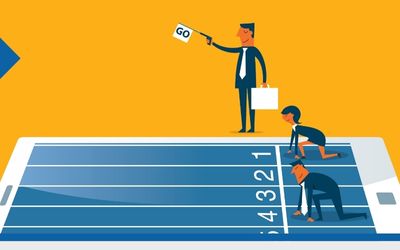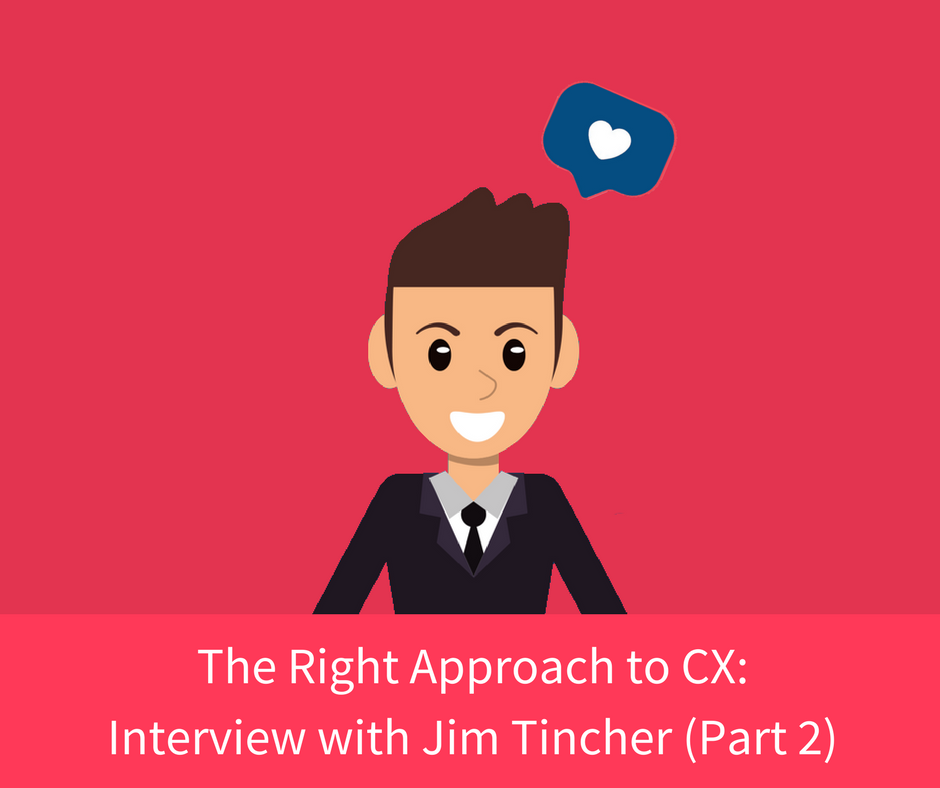Customer Experience: An Interview with Jim Tincher (Part 2)
In part-one of our interview, Jim - founder of Heart of the Customer and Certified Customer Experience Professional (CCXP) - provides many great...
7 min read
 Sarah Beckett
April 12, 2024
Sarah Beckett
April 12, 2024

Ask any customer experience (CX) professional, and they’ll tell you that exceptional customer experiences drive increased revenue.
The reason why? Happy customers are loyal customers who bring both repeat and new business by word of mouth. According to a survey by PwC, 73% of customers consider a positive customer experience an important factor in purchasing decisions.
However, how can leaders measure the return on investment (ROI) and impact of customer experience management (CEM) programs over time?
In this blog, we’ll discuss the top customer experience KPIs and how to calculate them. This will empower you, as a decision-maker, to determine which ones are right to track Customer Experience performance.
Keep reading to learn more about this topic, or click here to jump straight to our list of the top 17 Customer Experience KPIs.
Because there’s so much information about key indicators and customer experience metrics, decision-makers can get overwhelmed easily.
Here are a few considerations before deciding how to measure and what should be measured.
Let’s consider a Quick-Serve Restaurant (QSR) brand. For decision-makers in this industry, key touchpoints include the drive-thru lane, kiosks, mobile app, in-store and pick-up interaction, etc.
To make informed business decisions, brands should understand customers' actions at each touchpoint and assess their impact on the business.
After mapping touchpoints, it’s time to understand their influence on customer experience. For instance, in grocery stores, is the impact of not having a self-checkout the same as not having a loyalty program?
The answer depends on the brand promise. Customers probably won't feel dissatisfied if they don't expect self-checkout lanes.
Once they answer these questions, brands can determine how and what should be measured to improve customer experiences and business performance.
It refers to the time a company takes to deliver its products or services to customers. For some brands, faster service enhances the customer experience and increases throughput, leading to higher sales and repeat business.
Leading brands are strategizing on service speed. For instance, Taco Bell has recently opened its DefyTM location in Brooklyn Park, Minnesota, intending to reduce service time to two minutes or less.
To put this in perspective, this is less than half the average service time of ten major QSR brands, including other Taco Bell locations, as found in Intouch Insight's 22nd Annual Drive-Thru Study.
Order accuracy is a metric used to evaluate how accurately a brand fulfills customers' orders, which directly affects customer satisfaction. It’s calculated as follows:
Order Accuracy Rate = # Accurate orders / # Total Orders * 100
For retailers selling online, for example, order accuracy is essential. Whether it's receiving the right product or having all components in place, accuracy directly influences customer satisfaction and loyalty.
Meanwhile, brands reduce the likelihood of returns or customer complaints, which minimizes the costs associated with order errors.
Food quality is a crucial metric for restaurant operators, convenience store leaders, and grocers. It assesses the taste, freshness, presentation, and overall satisfaction with the food served by a restaurant or other establishment.
Food quality is usually evaluated from a customer perspective through customer feedback surveys or mystery shopping. However, it can also be assessed from an operational perspective using inspections and quality control checks.
Maintaining high food quality is essential for customer satisfaction, repeat business, and positive word-of-mouth. It also helps build a strong brand reputation and ensures health and safety standards compliance.
Friendliness scores play a vital role in measuring the level of warmth and care that employees show toward customers.Typically, brands use customer surveys and mystery shopping to evaluate this metric.
As part of our customer experience studies, we often ask mystery shoppers to evaluate the friendliness of their interactions with employees. When an interaction is rated as friendly, it usually has a significant impact on other key performance indicators.
Average Order Value (AOV) helps businesses track the average amount customers spend in each transaction.
AOV ($) = Sales Revenue / Total # of Sales Transactions
AOV is a crucial factor that impacts a business's bottom line, as even a small increase or decrease directly affects revenue and profitability.
Strategies like upselling and cross-selling can increase AOV, drive incremental sales, and boost business performance.
By understanding customer preferences and needs, brands can also enhance AOV and provide valuable experiences to their customers.
The Cost per Interaction, or the Cost per Activity, helps brands calculate the cost of each customer interaction across different channels and touchpoints.
Cost per Interaction ($) = Total Cost Of Interactions / Total # Interactions
By reducing the cost per interaction through automation, self-service options, and improvements, brands can lower operational costs, improve efficiency, and enhance the overall customer experience.
NPS measures the likelihood of customers recommending a brand on a scale from 0 to 10. High NPS scores indicate satisfied customers. The impact? Happy customers usually share positive experiences with friends and family and keep coming back for more. To calculate it:
NPS = (%) Percentage of Promoters - (%) Percentage of Detractors
Over 70% of customers will share a negative experience with their friends and family. (Source: Serving Up A Great Restaurant Experience - Deloitte)
CSAT measures how happy customers are with a specific transaction or overall experience. Brands usually use a survey tool to rate customers' interaction, using a scale from very dissatisfied to very satisfied.
By using CSAT, businesses can quickly gather real-time feedback on customer satisfaction. This information can help brands pivot faster, improve what is needed, and provide better experiences.
Customer Retention Rate is the percentage of customers who remain with a company over a given period. It’s calculated as follows:
Retention Rate (%) = (# of Customers at End of Period - # of Customers Acquired During Period) / Total # of Customers at Start of Period
Retaining customers is more cost-effective than acquiring new ones. Not only that, studies show that a 5% increase in customer retention can increase a company's revenue by 25-95%, depending on the industry.
Metrics related to engagement and interaction offer insights into the quality of interactions, operational efficiency, and overall customer experience. By measuring them, brands can improve customer loyalty, reduce churn rates, and increase revenue over time.
As the name suggests, Average Resolution Time (ART) is the average time it takes for customer issues to be resolved by customer support teams. It is calculated as shown below:
ART = Sum up the total resolution times for all cases / Total # of cases
Measuring ART helps brands identify bottlenecks in the support process that may require attention. Responding to customers efficiently and promptly minimizes their frustration, leading to higher customer satisfaction and loyalty.
First-Contact Resolution Rate (FCRR) measures the percentage of customer issues that are resolved during the initial interaction without requiring further follow-up.
FCRR = # of issues resolved on the first contact / Total # of customer inquiries
A high first-contact resolution rate enhances customer satisfaction by minimizing frustration and inconvenience. Reducing the need for customers to contact support repeatedly can also lead to cost savings and improved operational efficiency.
The Customer Effort Score (CES) measures how easy it is to engage with a brand, using rating scales from very easy to very difficult
A low CES means that customers have an easy and effortless experience, which can lead to greater customer loyalty, lower customer churn rates, and positive word-of-mouth. On the other hand, a high CES helps to identify areas where operations can be simplified to improve customer satisfaction.
Social Media Engagement Rate measures the interaction generated by a company's social media content, including likes, shares, comments, and clicks. Although most of the social media platforms provide this metric, here’s how it’s calculated:
Social media engagement rate = ( Total engagement / Total followers or impressions) * 100
A high Social Media Engagement Rate means the content resonates with the brand’s audience and effectively supports brand awareness, loyalty, and advocacy.
Net Emotion Score (NES) measures customers' overall sentiments following an interaction or experience with a brand.
Brands often use survey responses to evaluate customers' emotional experiences, on a scale from "Very Negative" to "Very Positive." The score is also calculated as follows:
NES = % of Positive Responses - % of Negative Responses
Understanding customer emotions when interacting with a brand can be challenging.
For instance, what would make a customer visit a restaurant for a second time? Is it because the restaurant meets their basic needs (food), or did the customer get something beyond their expectations?
Emotions associated with happiness, community, or trust could significantly influence customer behavior and decisions, foster loyalty, and drive repeat purchases.
Customer Lifetime Value (CLV), or Lifetime Value (LTV), is the projected revenue a single customer will generate for a business while they remain a client.
CLV ($) = Avg. Transaction Size ($) * Avg. Purchase Frequency * Retention Period
Retaining existing customers is often less expensive than acquiring new ones. That's why nurturing existing customer relationships is essential, as it provides added value to their experiences.
Customer Acquisition Cost (CAC) is the money a brand spends to acquire a new customer. It includes marketing, sales, advertising, and promotional expenses.
CAC ($) = Sales and Marketing Costs / # of New Customers Acquired
By optimizing CAC, businesses can reduce the costs associated with customer acquisition while increasing the efficiency of sales and marketing efforts. This, in turn, enables them to achieve a positive return on investment (ROI) and sustainable growth.
Pro Tip: Compare your Customer Acquisition Cost to your Customer Lifetime Value. If the acquisition cost is higher, consider strategies to increase the value of the interactions after a customer has been acquired.
Customer Churn Rate is the percentage of customers who stop doing business with a company within a given period. It’s directly related to customer dissatisfaction, and it’s calculated as shown below:
Customer Churn Rate (%) = (# of Lost Customers / # of Total Customers) * 100
Addressing why customers leave helps companies improve customer experience, identify gaps, and find opportunities for targeted retention efforts. It also leads to increased revenue and builds a strong brand reputation.
Brands must monitor key performance indicators (KPIs) that give them valuable insights into business performance and customer experiences. By analyzing these metrics, companies can identify areas for improvement and create strategies that meet evolving customer needs.
It's also essential for businesses to keep an eye on shifts in consumer behavior and preferences. This will allow them to quickly adapt to new customer needs and expectations, which will have a direct impact on customer experience KPIs.
By understanding relevant and meaningful metrics for their specific business objectives, brands can align their efforts with customer expectations and drive business results.
Want to learn more about tracking the success of your Customer Experience program?
Any questions? We'd love to hear from you. Reach out to our team at letschat@intouchinsight.com.

In part-one of our interview, Jim - founder of Heart of the Customer and Certified Customer Experience Professional (CCXP) - provides many great...

In the dynamic, competitive restaurant industry, every customer interaction counts. Whether through efficient drive-thru lanes, user-friendly...
![How to Create a CX Approach for Maximum Impact [White Paper]](https://www.intouchinsight.com/hubfs/How%20to%20create%20a%20CX%20approach%20for%20maximum%20impact%20%5Bwhitepaper%5D.png)
There are several trends occurring across the world that are contributing to hyper-competition around customer experience. Increasingly educated and...